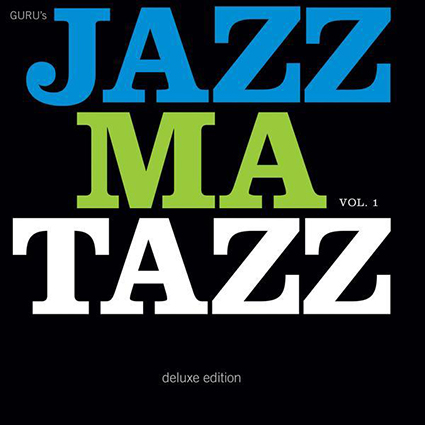
Billed on its sleeve as an “experimental fusion of hip-hop and jazz,” the 1993 release of Guru’s Jazzmatazz delivered historical perspective, seriousness of intent, and organic richness in a sweet-sounding package that, rather than succumbing to grandiosity, registered as a natural (and inevitable) encounter. It was a landmark affair that spawned numerous sequels, but UMG’s Urban Legends division has kept the focus on the first with a sharp 25th anniversary expansion, adding instrumental versions and a rack of remixes for a total of three LPs. Certain to be cherished by longtime fans, this edition’s approachable depth and diversity make it a worthwhile pick-up for appreciative newbies. It’s out now.
Although the parameters of its ambition get established in its opening introductory track, Jazzmatazz is a crisp pleasure to listen to throughout, and its success now stands as an essential chapter in the voluminous tome that is ’90s hip-hop’s golden era. Like the music of his contemporaries, Guru, an MC who came to prominence in the Brooklyn-based duo Gang Starr (alongside turntable wizard DJ Premier), was a meticulous and levelheaded purveyor of urban groove science, and it was through this approach that he shared a baseline with the jazz that is his most celebrated album’s inspiration.

Too many fusions are nearer to patchwork, but Jazzmatazz not only seamlessly blends elements of post-bop and soul-jazz (its cover design in homage to the bountiful achievements of the Blue Note label) with the thrust of cutting-edge East Coast hip-hop, it also pulls off the tricky combination of live instrumentation (which works better at deepening the relationship of hip-hop and jazz than it does in other’s attempts to fuse rap and rock) and the style’s original tools, namely a pair of turntables, some records, and a microphone.
If a byproduct of the LP was the mass awakening of doubters to hip-hop’s burgeoning artistry (a still somewhat contentious topic in ’93), there were no traces of pleading for acceptance (and by extension, lessened impact). Instead, Guru (who sadly passed in 2010) cut an album that aficionados would be (and still are) proud to pull off the shelf, its contents also dropping a knowledge bomb regarding the general connectedness of African-American musical experience.
It all coheres exquisitely right off the bat in “Loungin’.” There is Guru’s word flow and distinctive tone, simultaneously calm and intense, as he expands on the nature of serious relaxation and his music’s place in history of delivering it. There is the rhythm, sturdy but supple as it reinforces the aura of uncut hip-hop, and then there is Donald Byrd on trumpet and piano, his contribution adding the crucial jazz flavor as the cut just rolls with assurance.
Establishing that jazz held more than one gravelly voiced trumpeter, Byrd is also sampled in conversation with Guru on the topic of jazz and rap, their talk strategically rising and falling in the mix. But just as importantly, there’s a borrowing of Monk Higgins’ “Showdown,” the bedrock tactic of sampling extending beyond the introduction’s looped trumpet to establish (along with the rhythms and the rhyming, natch) the merger of hip-hop’s foundational qualities with live instrumental contributions from a series of distinguished guests.
Amongst others, Jazzmatazz features saxophonist Branford Marsalis on “Transit Ride,” pianist Lonnie Liston Smith on “Down the Backstreets,” and saxophonist Courtney Pine on closer “Sights in the City.” These are all highlights on a trim record (lacking the slightest in excess), but the arrival of Roy Ayers’ vibraphone (foreshadowed in side two’s opener “Respectful Dedications”) on “Take a Look (At Yourself)” is especially effective.
The guesting guitarists Zachary Breaux on “Transit Ride” and Ronny Jordan on “No Time to Play” underscore a predilection for soul-jazz (and a mild congruence with the era’s acid jazz uprising), as does the flute of Gary Barnacle on “Slicker Than Most” and Pine on “Sights of the City.” However, the vocals of N’Dea Davenport (she of the Brand New Heavies) on “When You’re Near” and “Trust Me,” Dee C. Lee on “No Time to Play,” and Carleen Anderson on “Sights in the City” solidify a recurring flavor of R&B that mingles with the jazzy aura exceptionally (and somewhat surprisingly) well.
But it’s the spectacularly funky “Slicker Than Most” and “Le Bien, Le Mal” with guesting French rapper MC Solaar that drive home the commitment to hip-hop’s bona fides, as does this edition’s bonus album of instrumentals. Beyond the obvious lack of voices, the tracks are strikingly distinctive and further illuminate hip-hop technique as the essential platform in Guru’s experiment. It’s a stone treat for the ears and not a bit limited in appeal to old-school hip-hop diehards.
Those already passionate will likely be familiar with the album of remixes that serves to broaden an already damn nigh inexhaustible record. Of course, it should be noted that Guru wasn’t the first to combine hip-hop and jazz. Along with Stetsasonic’s “Talkin’ All That Jazz,” there’s a considerable trail of samples throughout the music’s formative years.
However, the closest precedent is probably “Verses from the Abstract,” which features bassist Ron Carter, from A Tribe Called Quest’s ’91 The Low End Theory. For lovers of that cut and its masterpiece album who are somehow unfamiliar with Guru’s Jazzmatazz, a splendid discovery is in store, and this anniversary set is a marvelous expansion.
GRADED ON A CURVE:
A














































